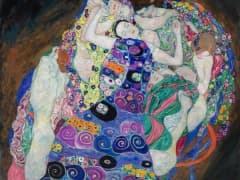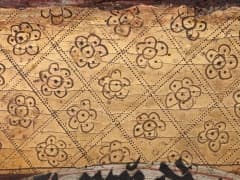
- Publikováno: 07. February 2021
An interview with the cofounder of The Pudil Family Foundation. About a small family business, life in a free world, and global ambitions. About the future of Kunsthalle Praha, but also about the importance of understanding our own history.

- Publikováno: 31. July 2019
Kovanda kissed through glass and Ondák exhibited the colours of autonomy in Barcelona.

- Publikováno: 13. September 2018
It was a century ago this year that two major artists of modernism died – Gustav Klimt (1862–1918) and Egon Schiele (1890–1918). This sad anniversary is commemorated by their joint exhibition at the Trade Fair Palace in Prague. The year of their deaths also marks the end of Austria-Hungary, a rich cultural empire that was home to both artists. Thus, their works will be placed within the context of Viennese modern artists, including Oskar Kokoschka, Emil Orlik, and Josef Hoffmann.

- Publikováno: 18. April 2018
To mark the 80th birthday of Zbyšek Sion (*12 April 1938), the leader of the Czech informel movement, the Klatovy / Klenová Gallery, in cooperation with curator Milan Dospěl, has prepared a retrospective exhibition titled Zbyšek Sion / Paintings. Informel, also called Art Brut or Outsider Art, spread in the Czech Republic in the 1950s as an (informal) protest capturing existential angst, urgency and solitude in the totalitarian regime.

- Publikováno: 18. April 2018
Through the fictional company UNES-CO, Kateřina Šedá is offering paid positions to “citizens of Český Krumlov” with the job description of carrying out “a normal life.” “Employees” will be compensated with wages for a three-month stay in a company apartment in the center of town and will perform everyday activities such as airing out pillows in windows, playing football in the street or taking a walk with a stroller. With this performance, Kateřina Šedá is drawing attention to the issue of tourist cities where residents have abandoned the centers and have moved to the edge of towns.

- Publikováno: 18. April 2018
As part of its Grand Opening 2018, the National Gallery in Prague will bring five new exhibitions to the scene, led by artists Katharina Grosse, Maria Lassnig and Patricia Dauder. The National Gallery is continuing its new programme focus, which intends to enrich the Czech scene with international projects and tailor-made works for the Trade Fair Palace. New shows and a concert by the Slovak alternative singer Katarína Máliková can be enjoyed on 15 February at 7pm at the Trade Fair Palace.

- Publikováno: 18. April 2018
Graduates of the Academy of Fine Arts in Prague have left their studios and moved their work to the National Gallery as part of the exhibition New Wave. 2017 AVU graduates. Despite waves representing something constant, repeating with every orbit of the moon in high and low tides, every wave has the possibility of bringing something new to the shore. The exhibition thus continues in the footsteps of the Nouvelle Vague of cinematography of the 1960s, the New Wave of popular music of the 1970s and 80s, as well as the New Wave of Slovak photography of the 1980s.

- Publikováno: 12. April 2018
The Czech Republic has its own pioneer of abstract art — František Kupka — who stands beside artists such as Wassily Kandinsky or Piet Mondrian. But František Kupka’s contributions often remain neglected in an international context. Kupka’s irreplaceable role as a pioneer of abstract art is currently highlighted by the Grand Palais in Paris in a retrospective exhibition which includes three works from the collection of The Pudil Family Foundation: Study for 'Pleasures' (1901), Signum (1907) and Battalian of Legionnaires (1918). The exhibition was prepared by curator Brigitte Leal and art historians Markéta Theinhardt and Pierre Brullé.

- Publikováno: 27. March 2018
One of the most important photographers in the world, Josef Koudelka, is exhibiting his cycle of large-format photographs titled De-Creazione, at the Trade Fair Palace in Prague; Koudelka has donated the works to the state. The cycle was created at the initiative of the Vatican, which, for its first presentation at the Venice Biennale in 2013, invited artists to present works based on the three basic themes of the Book of Genesis: creation, destruction and re-creation.

- Publikováno: 19. December 2017
The National Gallery in Prague presents richly decorated works of medieval masters in the exhibition For the Eyes to Admire. Decorative Techniques in Medieval Painting and Sculpture, 14th – 16th Centuries. While the previous exhibition What the Eyes Cannot See examined drawings hidden under the surface, now we are able to admire intricate details that were intended to catch our attention and deepen our aesthetic enjoyment of the paintings and sculptures.











